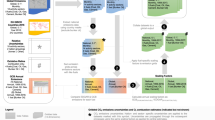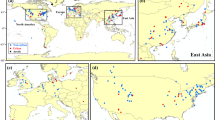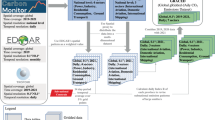Abstract
At present, global CO2 emission inventories are mainly based on bottom-up estimates that rely, for example, on reported fossil fuel consumptions and fuel types1,2. The associated uncertainties propagate into the CO2-to-NOx emission ratios that are used in pollution prediction and monitoring3, as well as into biospheric carbon fluxes derived by inverse models4. Here we analyse simultaneous and co-located satellite retrievals from SCIAMACHY (ref. 5; SCanning Imaging Absorption SpectroMeter for Atmospheric CHartographY) of the column-average dry-air mole fraction of CO2 (refs 6, 7) and NO2 (refs 8, 9, 10) for the years 2003–2011 to provide a top-down estimate of trends in emissions and in the ratio between CO2 and NOx emissions. Our analysis shows that the CO2-to-NOx emission ratio has increased by 4.2 ± 1.7% yr−1 in East Asia. In this region, we find a large positive trend of CO2 emissions (9.8 ± 1.7% yr−1), which we largely attribute to the growing Chinese economy. This trend exceeds the positive trend of NOx emissions (5.8 ± 0.9% yr−1). Our findings suggest that the recently installed and renewed technology in East Asia, such as power plants, transportation and so on, is cleaner in terms of NOx emissions than the old infrastructure, and roughly matches relative emission levels in North America and Europe.
This is a preview of subscription content, access via your institution
Access options
Subscribe to this journal
Receive 12 print issues and online access
$259.00 per year
only $21.58 per issue
Buy this article
- Purchase on Springer Link
- Instant access to full article PDF
Prices may be subject to local taxes which are calculated during checkout



Similar content being viewed by others
References
Olivier, J., Janssens-Maenhout, G., Muntean, M. & Peters, J. Trends in global CO2 emissions: 2013 Report (European Commission’s Joint Research Centre, 2013)
Boden, T., Marland, G. & Andres, R. Global, Regional, and National Fossil-Fuel CO2 Emissions (Carbon Dioxide Information Analysis Center, Oak Ridge National Laboratory, 2013).
Zhang, Q. et al. NOx emission trends for China, 1995–2004: The view from the ground and the view from space. J. Geophys. Res. 112, D22306 (2007).
Peters, W. et al. An atmospheric perspective on North American carbon dioxide exchange: Carbontracker. Proc. Natl Acad. Sci. USA 104, 18925–18930 (2007).
Bovensmann, H. et al. SCIAMACHY—Mission objectives and measurement modes. J. Atmos. Sci. 56, 127–150 (1999).
Reuter, M. et al. A method for improved SCIAMACHY CO2 retrieval in the presence of optically thin clouds. Atmos. Meas. Tech. 3, 209–232 (2010).
Reuter, M. et al. Retrieval of atmospheric CO2 with enhanced accuracy and precision from SCIAMACHY: Validation with FTS measurements and comparison with model results. J. Geophys. Res. 116, D04301 (2011).
Richter, A. & Burrows, J. P. Tropospheric NO2 from GOME measurements. Adv. Space Res. 29, 1673–1683 (2002).
Hilboll, A. et al. Improvements to the retrieval of tropospheric NO2 from satellite—stratospheric correction using SCIAMACHY limb/nadir matching and comparison to Oslo CTM2 simulations. Atmos. Meas. Tech. 6, 565–584 (2013).
Hilboll, A., Richter, A. & Burrows, J. P. Long-term changes of tropospheric NO2 over megacities derived from multiple satellite instruments. Atmos. Chem. Phys. 13, 4145–4169 (2013).
IPCC, Climate Change 2013: The Physical Science Basis (Cambridge Univ. Press, 2013).
Bovensmann, H. et al. A remote sensing technique for global monitoring of power plant CO2 emissions from space and related applications. Atmos. Meas. Tech. 3, 781–811 (2010).
BP statistical review of world energy (BP, 2013); www.bp.com/statisticalreview
Kurokawa, J. et al. Emissions of air pollutants and greenhouse gases over Asian regions during 2000–2008: Regional Emission inventory in ASia (REAS) version 2. Atmos. Chem. Phys. 13, 11019–11058 (2013).
Guan, D., Liu, Z., Geng, Y., Lindner, S. & Hubacek, K. The gigatonne gap in China’s carbon dioxide inventories. Nature Clim. Change 2, 672–675 (2012).
Richter, A., Burrows, J. P., Nüß, H., Granier, C. & Niemeier, U. Increase in tropospheric nitrogen dioxide over China observed from space. Nature 437, 129–132 (2005).
Wunch, D., Wennberg, P. O., Toon, G. C., Keppel-Aleks, G. & Yavin, Y. G. Emissions of greenhouse gases from a North American megacity. Geophys. Res. Lett. 36, L15810 (2009).
Turnbull, J. C. et al. Atmospheric observations of carbon monoxide and fossil fuel CO2 emissions from East Asia. J. Geophys. Res. 116, D24306 (2011).
Silva, S. J., Arellano, A. F. & Worden, H. M. Toward anthropogenic combustion emission constraints from space-based analysis of urban CO2/CO sensitivity. Geophys. Res. Lett. 40, 4971–4976 (2013).
Berezin, E. V. et al. Multiannual changes of CO2 emissions in China: Indirect estimates derived from satellite measurements of tropospheric NO2 columns. Atmos. Chem. Phys. 13, 9415–9438 (2013).
Schneising, O. et al. Anthropogenic carbon dioxide source areas observed from space: Assessment of regional enhancements and trends. Atmos. Chem. Phys. 13, 2445–2454 (2013).
Kort, E. A., Frankenberg, C., Miller, C. E. & Oda, T. Space-based observations of megacity carbon dioxide. Geophys. Res. Lett. 39, L17806 (2012).
Ummel, K. CARMA Revisited: An Updated Database of Carbon Dioxide Emissions From Power Plants Worldwide (Center for Global Development, 2012) http://www.cgdev.org/content/publications/detail/1426429
Beirle, S., Platt, U., Wenig, M. O. & Wagner, T. Weekly cycle of NO2 by GOME measurements: A signature of anthropogenic sources. Atmos. Chem. Phys. 3, 2225–2232 (2003).
Zhou, Y., Brunner, D., Hueglin, C., Henne, S. & Staehelin, J. Changes in OMI tropospheric NO2 columns over Europe from 2004 to 2009 and the influence of meteorological variability. Atmos. Environ. 46, 482–495 (2012).
Stavrakou, T., Mueller, J-F., Boersma, K. F., De Smedt, I. & van der A, R. J. Assessing the distribution and growth rates of NOx emission sources by inverting a 10-year record of NO2 satellite columns. Geophys. Res. Lett. 35, L10801 (2008).
Kurokawa, J-i., Yumimoto, K., Uno, I. & Ohara, T. Adjoint inverse modeling of NOx emissions over eastern China using satellite observations of NO2 vertical column densities. Atmos. Environ. 43, 1878–1887 (2009).
Gu, D., Wang, Y., Smeltzer, C. D. & Liu, Z. Reduction in NOx emission trends over China: Regional and seasonal variations. Environ. Sci. Technol. 47, 12912–12919 (2013).
Crisp, D. et al. The Orbiting Carbon Observatory (OCO) mission. Adv. Space Res. 34, 700–709 (2004).
Acknowledgements
This work was in part funded by ESA/ESRIN (GHG-CCI), EU FP7 (MACC-II), DLR (SADOS), and the State and the University of Bremen. We acknowledge the use of data from the Emission Database for Global Atmospheric Research (EDGAR), BP’s statistical review of world energy, the Regional Emission inventory in ASia (REAS), the Global Carbon Project (GPC), and the CARMA (CARbon Monitoring for Action) database. Thanks also to the ECMWF for providing the meteorological reanalysis data.
Author information
Authors and Affiliations
Contributions
M.R.: experimental set-up, data analysis, interpretation, design and operation of the XCO2 satellite retrieval, writing the paper. M.B., M.H., J.H., O.S., H.B., J.P.B.: experimental set-up, interpretation, design of the XCO2 satellite retrieval, improving the paper. A.H., A.R.: experimental set-up, interpretation, design and operation of the NO2 satellite retrieval, improving the paper.
Corresponding author
Ethics declarations
Competing interests
The authors declare no competing financial interests.
Supplementary information
Supplementary Information
Supplementary Information (PDF 3407 kb)
Rights and permissions
About this article
Cite this article
Reuter, M., Buchwitz, M., Hilboll, A. et al. Decreasing emissions of NOx relative to CO2 in East Asia inferred from satellite observations. Nature Geosci 7, 792–795 (2014). https://doi.org/10.1038/ngeo2257
Received:
Accepted:
Published:
Issue Date:
DOI: https://doi.org/10.1038/ngeo2257
This article is cited by
-
Impact of COVID-19 force confinement for CO2 emission, NO2 concentration, and daily traffic congestion throughout EU nations and the United Kingdom (UK)
International Journal of Environmental Science and Technology (2024)
-
Possible connection between the East Asian summer monsoon and a swing of the haze-fog-prone area in eastern China
Theoretical and Applied Climatology (2018)
-
Space-based detection of missing sulfur dioxide sources of global air pollution
Nature Geoscience (2016)
-
Extreme Air Pollution in Global Megacities
Current Climate Change Reports (2016)
-
Reduced carbon emission estimates from fossil fuel combustion and cement production in China
Nature (2015)



